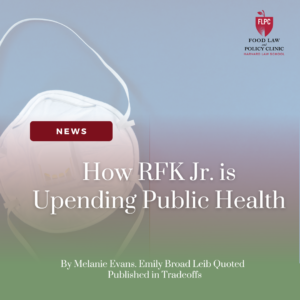This post was written by Emma Scott, Clinical Instructor, & Emily Broad Leib, Clinical Professor of Law & Director, HLS Food Law & Policy Clinic
Last week was a pivotal one for the meat and poultry industry in the United States. On Tuesday, President Trump issued an Executive Order (EO) under the Defense Production Act (DPA) directing the Secretary of Agriculture “to ensure that meat and poultry processors continue operations[.]” Two days earlier, the Occupational Safety and Health Administration (OSHA) and Centers for Disease Control and Prevention (CDC) released Joint Meat Processing Guidance for meat and poultry processing workers and employers, to which the Executive Order refers. The EO and Joint Guidance will shape the landscape of worker health and safety in this industry—and perhaps other segments of the food industry—throughout the pandemic, raising a number of practical and legal challenges.
The COVID-19 Pandemic Has Exacerbated Worker-Safety Concerns.
Deficient worker-safety precautions in the meat processing industry is not a new issue, but the coronavirus pandemic has magnified the problem and rightfully drawn attention to the dismal working conditions ubiquitous throughout the industry. Unfortunately, the “essential” task of maintaining the nation’s food supply often means that safe and desirable working conditions take a backseat to profitability and industry stability. Despite the clear risk to worker health, the new Joint Guidance—which is, actually, fairly good—remains discretionary, and President Trump’s Executive Order—while acknowledging the Guidance—did not go so far as to require industry compliance with it.
Compounding the issue further, the National Employment Law Project reports that “the number of [OSHA inspectors] has fallen to a 45-year low,” and advocacy groups across the country report a minimal enforcement response to a flood of increased workplace safety complaints in recent weeks. Since the national emergency began, OSHA’s daily inspection rate has dropped to less than a third of what it had been previously and citations have fallen by nearly 70 percent compared to prior years. These discouraging enforcement rates inspire little confidence that new Guidance will alleviate the very real risks workers face in continuing to work in meat processing facilities.
Employers Are Not Immune to Liability.
Despite President Trump’s proclamations that the EO would somehow shield processing plants from liability, it does not offer such blanket protection. While the DPA does confer immunity on businesses for “any act or failure to act resulting directly or indirectly from compliance with a[n] . . . order issued” under the DPA,[i] that immunity is narrowly cabined (i.e., breach of contract claims from another customer due to government contract’s priority) and is unlikely to discharge a business from its health and safety obligations to its employees.
In practice, facilities that adopt and adhere to the recent Joint Guidance will have a strong defense in any future legal action. As the Department of Labor (DOL) noted in its news release following the EO, “courts often consider compliance with OSHA standards and guidance as evidence in an employer’s favor in litigation.” The agency also expressly stated that it may even support employers in such litigation if they choose to follow the Joint Guidance. But, nothing from the EO, the Joint Guidance, or DOL’s statements indicates that employers will be immune from lawsuits due to workplace exposure, though clearly compliance with the Joint Guidance will tilt the scale to their advantage.
Although employers are not immune from suit, workers may still have to wait for their day in court. Yesterday, the District Court for the Western District of Missouri dismissed a case against Smithfield Foods in which workers claimed that the company was failing to implement adequate coronavirus-related safety precautions in their meat processing plant in Milan, Missouri. The Court relied on the primary jurisdiction doctrine to hold that OSHA should decide, in the first instance, whether Smithfield Foods is abiding by the Joint Guidance, for reasons of OSHA’s expertise in the subject matter and to promote uniformity in national enforcement. While the decision signals to would-be plaintiffs that courts may hesitate to intervene in such cases, advocates may find comfort in the facts that the suit caused the company to make significant changes to its policies, the filings indicate acceptance of the Joint Guidance as the new industry standard, and the Court may have come out differently had there been more flagrant and continuing safety violations.
Facility Closures May Still Occur.
The media has portrayed the President’s EO as requiring meat and poultry processing plants to reopen and/or remain open. However, the Order does not go so far, and it’s difficult to imagine the U.S. Department of Agriculture (USDA) forcing a plant to stay open if an acute outbreak occurs. Instead, the EO gives USDA the authority to make a determination as to whether a facility should continue operations.
For its part, DOL’s enforcement position with respect to these facilities is unclear. The agency has proclaimed that the Joint Guidance should not be used by state and local authorities to order a facility to close or remain closed. Further, DOL stated that OSHA is unlikely to cite employers that adhere to the Joint Guidance and assured that it “will take into account good faith attempts to follow” the Guidance. But DOL has not indicated how OSHA will respond if and when an employer is found to be out of compliance with the Guidance and whether it considers facility closure to be an available enforcement mechanism. In light of the EO, we would expect such action to be coordinated with USDA if it were to occur.
The Executive Order Stands on Shaky Legal Grounds.
Beyond the liability issue, the Order raises startling questions regarding the purpose of the DPA and the aims to which it may be put to use. While few questioned the President’s decision to use his DPA authority to facilitate procurement of ventilators and respirator masks, the justification for leveraging this power to prop-up segments of the food industry is more tenuous. The pandemic has challenged supply chains and created myriad issues for producers across the country, but the country is not facing a shortage of food. Despite the reduced availability of meat, there are plenty of other food stocks available to fill the gap. It is thus challenging to see how the President’s invocation of this extraordinary authority could be warranted in such circumstances.
The Defense Production Act authorizes the president to require that federal contracts and orders necessary to promote the national defense take priority over other contracts and to allocate materials, services, and facilities to further that defense effort.[ii] But, this power cannot be used to control distribution in the civilian market “unless the President finds (1) that such material is a scarce and critical material essential to the national defense, and (2) that the requirements of the national defense for such material cannot otherwise be met[.]”[iii] In his Executive Order, Trump expressly found that “meat and poultry in the food supply chain” meet these criteria. A plain reading of the statute’s text casts this declaration into doubt, and few legal scholars seem convinced of its merit.
The Executive Order May Foreshadow Additional Market Intervention.
The Order creates a disturbing precedent: the use of national defense authority to designate a segment of the food industry essential at a time when the nation’s food supply, on the whole, remains robust, and at the expense of worker health and safety. Can and should the DPA be used to prop up an arm of an industry in this manner?
While we would argue that the answer is no, there may be more to come. Although the Order specifically calls out the meat and poultry industry, it also delegates the President’s authority to “identify additional specific food supply chain resources that meet the criteria of section 101(b)” to the Secretary of Agriculture (emphasis added). Following the President’s lead, then, USDA could declare authority over any other segment of the food industry facing a supply chain issue or, as with the meat industry, closures due to coronavirus outbreaks or related health and safety concerns. We may thus soon see how this power grab plays out in other parts of the food system.
What’s Next?
Valid or not, the President’s Order has political bite, signaling the federal government’s priorities to the industry, regulators, and the American public.
On May 5, Secretary Perdue issued a letter directing “meat and poultry processors to utilize the [Joint Guidance] . . . to implement practices and protocols for staying operational or resuming operations[.]” He further directed those facilities that are closed and “without a clear timetable for near-term reopening” to submit their written protocol to USDA and resume operations as soon as possible. Last week, he also assured reporters that workers would receive more protective gear and access to coronavirus testing. He has stated that “worker health and safety is the first priority[,]” while promising that facilities would reopen in a matter of days.
Yet, the federal government’s prioritization of support for meat and poultry industry belies its overtures of concern for worker health and safety, which should be the priority. Not only is it unjust to require workers to return to precarious working conditions, especially given that facilities still are not required to implement the Joint Guidance, but this “solution” is short-sighted. Each day brings new reports of coronavirus outbreaks in these facilities. Endangering workers by sending them to work in unsafe facilities will increase the scale of outbreaks, threatening the long-term stability of the workforce essential to what the President has deemed a critical industry. In light of these threats, FLPC recommends the follow actions:
- The Joint Meat Processing Guidance must be made mandatory for all processing facilities;
- OSHA inspections and enforcement actions must dramatically increase through a coordinated response to ensure compliance with the Guidance and promptly address any worker complaints;
- Workers should receive hazard pay and significantly expanded paid sick leave; and
- Workers who choose not to return to these facilities for fear of their own health and welfare should remain eligible for unemployment assistance and/or other available paid leave benefits.
[i] 50 U.S.C. § 4557
[ii] 50 U.S.C. § 4511 (a)
[iii] 50 U.S.C. § 4511 (b)


Health Law & Policy, Commentary
Federal Government Cuts Health Grants and Grantees File Litigation in Response
April 21, 2025